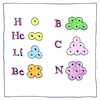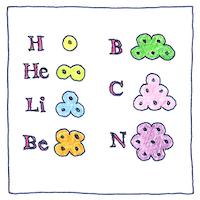William Prout
physics

|
Prout’s hypothesis
The atomic weights of the first fifty or so elements seemed to be whole number multiples of the atomic weight of hydrogen, so William Prout asked what if hydrogen were the only fundamental atom and other elements were actually groupings of hydrogen? But Prout’s hypothesis couldn’t explain the atomic weight of chlorine, with atomic number 17, 35.45 heavier than hydrogen. They didn’t know about electrons or neutrons. They didn’t know that samples of the elements they measured contained multiple isotopes. But Prout’s hypothesis started a chain of more careful measurements of the atomic weights of elements.
Proton, neutron
Prout called hydrogen the protyle, the prototype of elements. The hydrogen atom consists of one proton and one electron. When Ernest Rutherford knocked a proton from a nitrogen atom in 1917, he proposed that all nuclei were composed of hydrogen nuclei and he named it the particle a proton after Prout’s protyle. It wouldn’t be until 1920 that Rutherford proposed that nuclei also include neutrons and that a neutron might be a proton joined by an electron.
Hypothesis
In science, a plausible hypothesis is enough to spur progress. A useful error is admired more than a lucky guess. Would that the same be true for buying and selling stocks.



Others proposed even more outlandish theories about the structure of the atom, including plum puddings, cubes, knots, and tiny planetary rings or solar systems. Prout’s hypothesis was a persuasive approximation of reality; Francis W. Aston was awarded the Nobel Prize in Chemistry in 1922 partly for the “whole-number rule,” a refinement of Prout’s hypothesis that took the existence of isotopes into account.
See also in The book of science:
Readings in wikipedia: